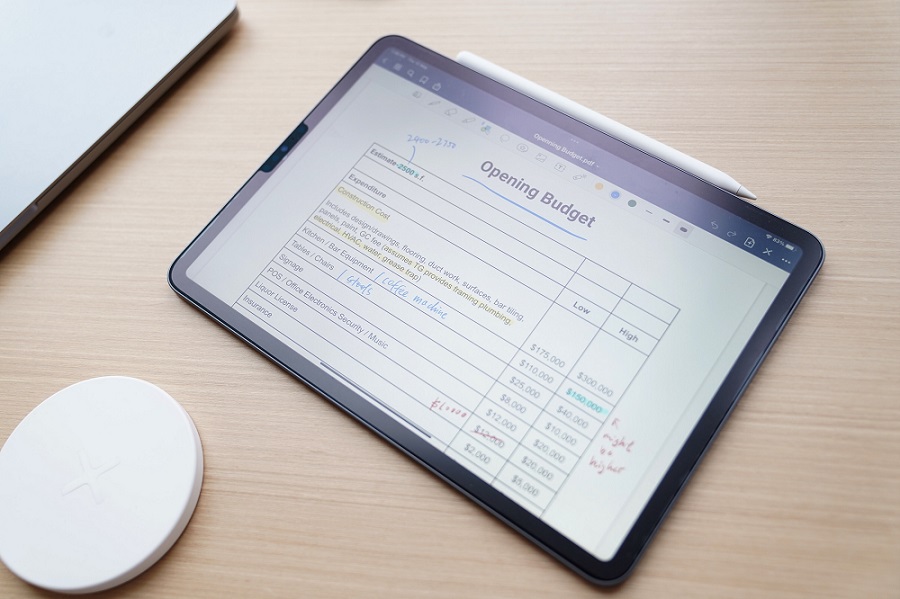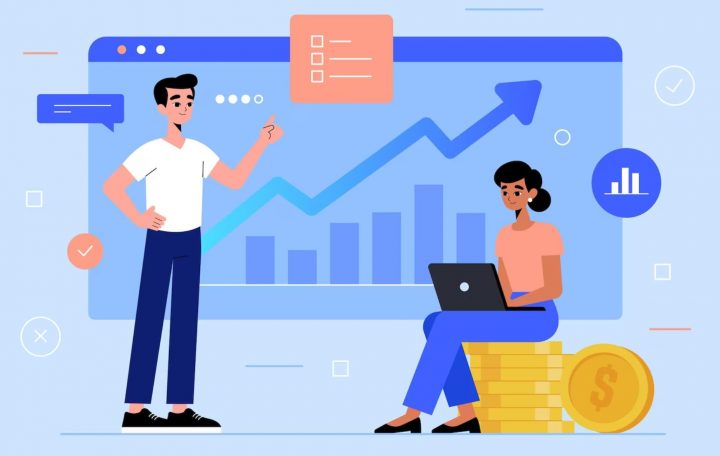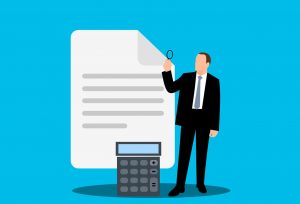In the world of business, forecasting is one of the most important processes that companies use to predict future financial performance. By analysing past data and market trends, businesses can create financial forecasts that can be used for predicting future revenue, expenses, and profit, which can help businesses make informed decisions about investments, hiring, and budgeting. Areas that are all of crucial importance to the business and how it progresses. However, the traditional methods of forecasting can be time-consuming, error-prone, and can cause significant disruptions to normal business operations. Fortunately, financial forecasting software with automated accounting can streamline financial forecasting and provide a range of benefits to companies.
What is financial forecasting?
Financial forecasting is a crucial process that involves making predictions and estimations about an organization’s financial performance in the short and long term.
Forecasting plays a fundamental role in Finance and FP&A (Financial Planning and Analysis), serving as the bedrock for decision-making worldwide. FP&A teams typically collaborate with the executive leadership (c-suite) and other business units to gather relevant data, analyze market trends, anticipate shifts, and ultimately create accurate forecasts.
Traditionally, forecasting has relied on a combination of historical and current performance data, as well as current trajectory, future market predictions, competitor performance, internal performance, strategic planning, and execution.
By leveraging this information, FP&A professionals can then project future revenues, profits, cash flow, expenses, and other essential financial metrics.
What is the difference between forecasting and budgeting?
Timeframe
The primary difference between forecasting and budgeting lies in their timeframe. Forecasting is concerned with predicting future outcomes over a more extended period, while budgeting focuses on creating a detailed financial plan for a specific period, usually a year.
Assumptions
Forecasting relies on historical data, statistical models, and market trends to make predictions. It involves assumptions based on available information. On the other hand, budgeting involves setting financial targets and allocating resources based on predetermined goals and objectives.
https://www.high-endrolex.com/49Flexibility
Forecasting is more flexible as it allows businesses to adapt to changing circumstances. It helps in adjusting strategies and making real-time decisions. Budgeting, on the other hand, is more rigid, as it outlines specific financial allocations for a set period.
Purpose
The purpose of forecasting is to estimate future trends and performance to prepare for potential scenarios. Budgeting’s main objective is to allocate resources efficiently and control spending to achieve organizational goals.
Tools and Techniques
Forecasting often involves statistical analysis, market research, and predictive modeling to arrive at projections. Budgeting, on the other hand, uses financial data, historical performance, and departmental input to create a comprehensive financial plan.
Decision-Making Process
Forecasting aids businesses in long-term strategic decisions and market positioning. Budgeting supports short-term tactical decisions and day-to-day financial management.

What is financial forecasting software?
To stay ahead in the competitive market, businesses require accurate and reliable tools to predict their financial performance. This is where financial forecasting software comes into play.
Financial forecasting software is a specialized application designed to help businesses predict their future financial outcomes based on historical data, market trends, and other relevant factors. It utilizes complex algorithms and statistical models to analyze the data, enabling businesses to make well-informed financial decisions.
How Does Financial Forecasting Software Work?
Financial forecasting software takes into account various inputs, including past financial data, sales figures, expenses, market trends, and economic indicators. It then processes this information through sophisticated algorithms to generate accurate forecasts for a specified period, such as the next quarter or fiscal year.
One of the significant advantages of this software is its ability to conduct scenario analysis. It allows businesses to explore various “what-if” scenarios and assess the impact of different decisions on their financial performance. For example, a company can simulate the effects of launching a new product, changing pricing strategies, or entering a new market before making any actual changes.
The Key Benefits of Financial Forecasting Software
a. Informed Decision-Making
Financial forecasting software equips businesses with valuable insights that aid in making informed decisions. With accurate predictions, organizations can allocate resources efficiently, plan for growth opportunities, and identify potential risks.
b. Budgeting and Resource Allocation
Forecasting software enables precise budgeting and resource allocation. Companies can allocate funds where they are most needed and identify areas where cost-cutting measures can be implemented without compromising efficiency.
c. Strategic Planning
By understanding future financial trends, businesses can create comprehensive strategic plans that align with their long-term objectives. This software helps organizations set achievable goals and chart a clear path toward success.
d. Identifying Trends and Patterns
Financial forecasting software uses historical data to identify trends and patterns that may not be apparent through manual analysis. This allows businesses to stay ahead of market fluctuations and capitalize on emerging opportunities.
Selecting the Right Financial Forecasting Software
a. User-Friendly Interface
Look for software that offers an intuitive and user-friendly interface. The easier it is to navigate and input data, the more efficient your forecasting process will be.
b. Integration Capabilities
Ensure that the software can seamlessly integrate with your existing financial systems and data sources. This minimizes data entry errors and streamlines the forecasting process.
c. Accuracy and Reliability
Choose a software solution with a proven track record of accuracy and reliability. Check for reviews and testimonials from other users to gauge the software’s performance.
d. Scalability
Consider the scalability of the software to accommodate your business’s growth. A flexible solution can adapt to changing business needs without requiring frequent upgrades.

What are the methods of financial forecasting?
Traditional accountancy methods of forecasting usually involved manually analysing past financial data to make predictions about future performance. This often meant spending hours reviewing historical income statements, balance sheets, and cash flow statements to identify trends and patterns that could help predict the company’s future financial position.
A team of accountants would use integrated accounting solutions with various ratio analysis techniques to uncover insights into the company’s financial performance, liquidity, and solvency. Additionally, forecasting methods such as trend analysis, regression analysis, and moving averages were also commonly used to predict future financial trends.
However, these traditional methods were limited in their ability to account for external factors such as market trends or changes in consumer behaviour, which could impact a company’s financial performance. Fortunately, today the world of forecasting has completely been transformed. Instead of spending a substantial amount of your time collating all of the data from various sources, you have the ability to generate a higher level of forecasting information at the touch of a button.
Working in partnership with 4pointzero, you will be able to move away from these clunky traditional methods and completely revolutionise your forecasting ability to include not only internal company information, but wider external factors too through scenario planning.
Key challenges and how 4pointzero solves them
It is crucially important to get the financial information correct in the first instance. Forecasting includes analysing financial data to make predictions about the future, but if the historical data isn’t accurate it will be impossible for the forecasting to be reliable and meaningful. During a series of workshops, 4pointzero will highlight to you, how our automated financial solutions eliminate the need for manual data entry and thereby remove the opportunity for oversights.
Instead, we will draw your attention to how reliable your information will be and promote it as a solid platform to build your forecasting on. Safe in the knowledge that the initial inputs are correct, 4pointzero will progress to helping you focus on how to use the financial forecasting software to make useful financial forecasts that will support important decisions you need to make.
What is more, integrating 4pointzero’s accounting solutions will undoubtedly help your business become more efficient and productive. Gone will be the tedious hours spent by a team of accountants manually sourcing, compiling and analysing the data for forecasting. 4pointzero’s accounting solutions with financial forecasting software will give time back to your business and employees. They will be free to focus their valuable time on putting the financial forecasting to good use and completing more stimulating strategic activities. Business forecasting software can result in a more motivated workforce and lead to increased profitability.
The speed at which the forecasting information is readily available to you and the mere fact that it is based on real-time insight, is another key benefit of permitting 4pointzero to integrate our accounting solutions into your business. Traditional forecasting methods often involve a significant time lag between data collection and analysis. By the time you have managed to compile all of your reports and present your findings, the information is out of date, making the whole activity somewhat pointless.

This is simply not the case with automated software and by knowing this how could you possibly decide not to proceed with integration? Also to be noted, 4pointzero’s accountancy solutions have the expert ability to analyse financial data as it is generated. Your business will be provided with real-time insights into its financial performance at the point of the report being generated. This can be especially useful for your business when it needs to respond quickly to changes in the market or its own operations.
Why 4pointzero Financial Forecasting software?
Financial forecasting activities need to be completed by each department, so that budgets can be allocated accordingly. 4pointzero offer training and support for stakeholders chosen by you, on how to get the best out of our accounting solutions prior to and post implementation. Our accounting experts will coach you on how you can extract the forecasting information you require and place you in the best possible position to secure the correctly aligned budget for each department.
By the same token, automating accounting forecasting also improves collaboration and communication between teams when it comes to collating the forecasting information. Traditional forecasting methods often involve input from multiple departments, such as finance, sales, and marketing, which can create communication challenges. By using automated accounting, we can show you how all teams can access the same data and reports for their inputs, which can streamline your decision-making processes.
Furthermore, 4pointzero’s financial forecasting software can provide your with a range of forecasting tools and techniques. It is not solely about the internal information. Our automated accounting software can use predictive modelling to forecast financial performance based on historical data and market trends. This can provide you with a range of scenarios and insights into your future financial performance.
In conclusion, financial forecasting software is a powerful tool for financial forecasting that can provide businesses with a range of benefits. By reducing errors, saving time, providing real-time insights, improving collaboration and communication, and offering a range of forecasting tools and techniques, automated accounting can help businesses become more efficient, productive, and profitable.
As technology continues to evolve, the use of automated accounting solutions for financial forecasting is likely to become increasingly common and necessary for businesses to remain competitive in today’s fast-paced and ever-changing business environment.
Frequently Asked Questions (FAQ)
What is financial forecasting software?
Financial forecasting software is a powerful tool used by businesses to predict future financial outcomes based on historical data and current trends. It utilizes advanced algorithms and statistical models to analyze financial data, identify patterns, and generate accurate forecasts. By using this software, businesses can make informed decisions, set realistic goals, and plan for the future.
How can financial forecasting software benefit my business?
Financial forecasting software offers several benefits for businesses. It enables you to gain valuable insights into your financial performance, anticipate potential risks, and make informed decisions. By accurately predicting future outcomes, you can allocate resources effectively, manage cash flow, optimize budgeting and planning, and identify growth opportunities. This software empowers businesses to make data-driven decisions that can drive success and profitability.
What features should I look for in financial forecasting software?
When choosing financial forecasting software, it is essential to consider certain key features. Look for software that provides robust data analysis capabilities, supports multiple forecasting methods, and offers customizable reporting and visualization options. Integration with other financial tools and the ability to handle large datasets are also important. Additionally, user-friendly interfaces, collaboration features, and the ability to perform scenario analysis can enhance your forecasting process and help you achieve more accurate results.
Can financial forecasting software integrate with other business systems?
Yes, most financial forecasting software is designed to integrate seamlessly with other business systems. This integration allows for the automatic import and export of financial data from sources such as accounting software, enterprise resource planning (ERP) systems, and customer relationship management (CRM) platforms. By integrating with these systems, financial forecasting software can access relevant data in real-time, ensuring accurate and up-to-date forecasts. This integration streamlines the forecasting process and eliminates the need for manual data entry, saving time and reducing errors.
Is it possible to customize financial forecasting software to suit my business needs?
Yes, many financial forecasting software solutions offer customization options to align with specific business needs. You can typically customize various aspects of the software, such as forecasting models, reporting templates, and data visualizations. This flexibility allows you to tailor the software to match your industry, business size, and unique requirements. By customizing the software, you can ensure that it provides the most relevant and accurate forecasts for your specific business context.



